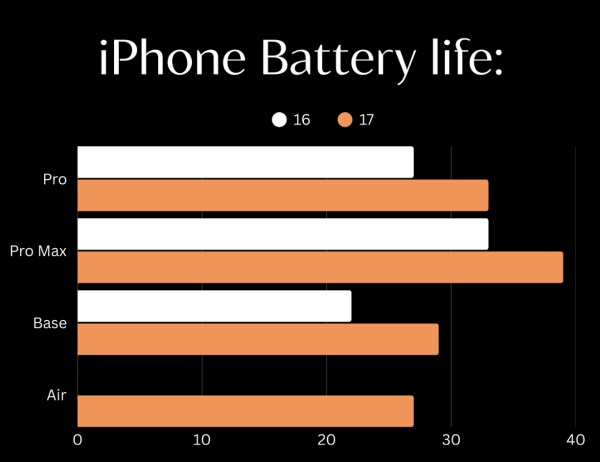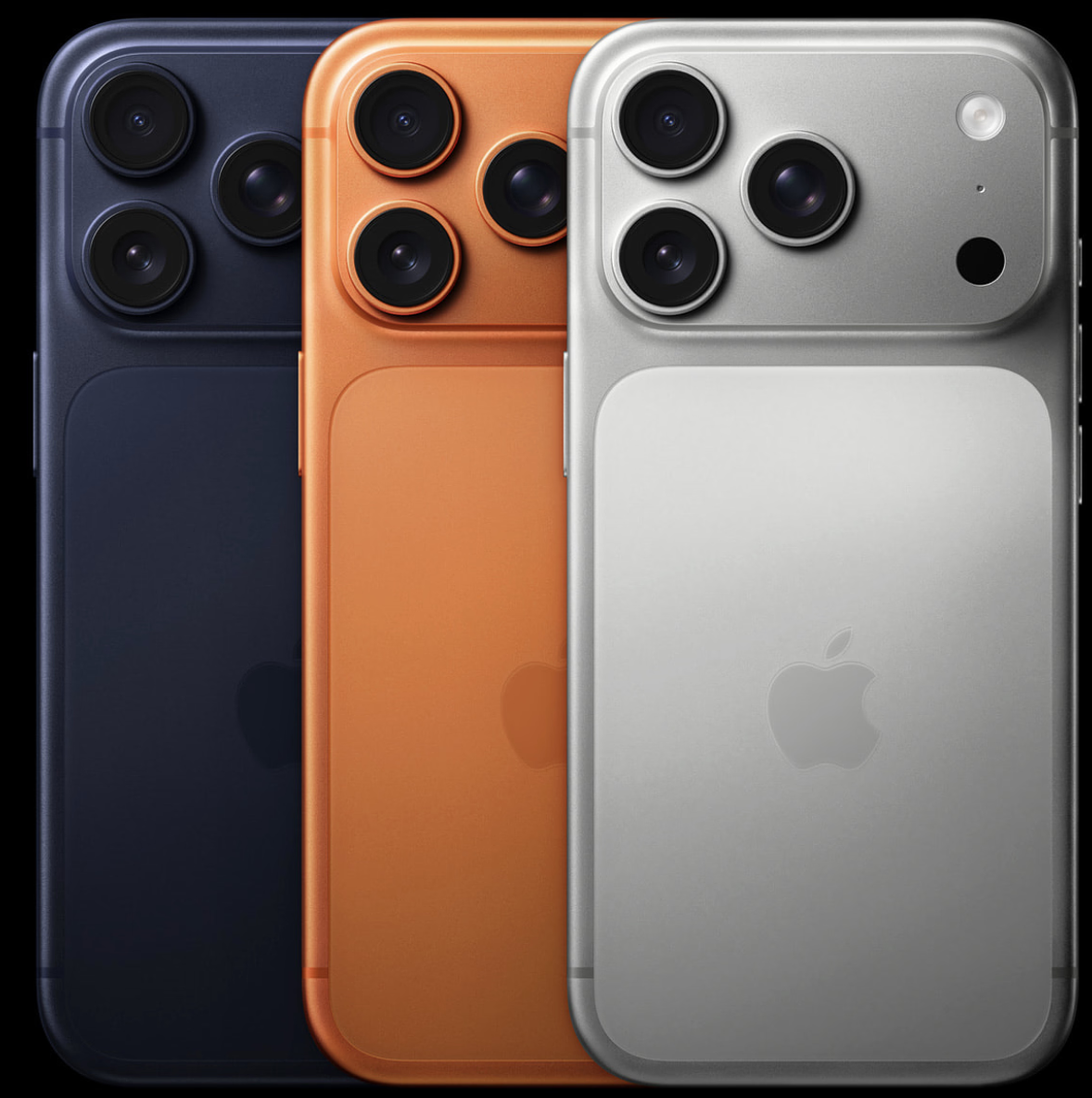Two weeks after its “Awe Dropping” event, Apple has unveiled its new lineup of iPhones, Watches and AirPods. Unsurprisingly, Apple has continued its typical four-product lineup of iPhones, a strategy it’s carried on since the iPhone 12. While Apple maintained its two standard models alongside its pro versions, the company replaced the standard models with a new statement piece.
iPhone Air:
The iPhone Air has been a frequent subject of discussion throughout the past year. However, Apple has addressed the speculation by releasing an iPhone that, according to MacRumors, can withstand up to 190 pounds of pressure before bending. By comparison, the iPhone 17 Pro withstands 200 pounds, and the 17 Pro Max holds up to 240 pounds. For context, the iPhone 6 bent at just 100 pounds. This endurance comes from a newly designed titanium frame, which keeps the phone lightweight and durable.
iPhone Air comes with the latest A19 Pro chip (same as the 17 Pro but with one fewer GPU core). In Geekbench 6 (a benchmarking system that gives a score based on processing power and how fast the phone works during typical day-to-day use), multi-core testing, it outperformed the iPhone 16 Pro (A18 Pro Chip) by 15%, though it lags the Samsung Galaxy S25 Ultra (Snapdragon 8 Elite for Galaxy chip) by 4%.
The iPhone Air is available in four colors: Sky Blue, Light Gold, Cloud White and Space Black.
Apple reports that the iPhone Air offers 27 hours of playback, compared to 30 hours on the iPhone 17 and 39 Hours on the iPhone 17 Pro.
The new iPhone features a single 48-megapixel rear camera, which is the same camera as on the iPhone 16e and the primary camera on the iPhone 16 and 17.
iPhone 17:
The iPhone 17 features the same rear glass with a vertical dual camera setup as the previous generation iPhone 16 and 16 Plus. However, Apple has chosen not to release a 16 Plus model this year, likely using the iPhone Air as its substitute.
The rear camera remains unchanged, featuring a 48-megapixel primary sensor and a 48-megapixel ultrawide camera, as seen on the iPhone 16 and 16 Plus. However, the front (selfie) camera has been updated with a square sensor rather than a rectangular one. This change allows users to take photos in landscape mode without having to rotate their phone. Additionally, this allows the phone to capture ultrawide front camera photos.
The iPhone 17 is powered with an A19 chipset, which is more efficient than previous generations, using less battery in everyday tasks.
Available in pastel colorways, the iPhone 17 offers lavender, sage, mist blue, white and black options, a divergence from the bright colors of the iPhone 16.
Apple has also added 120Hz ProMotion to all phones in the new lineup, including the base iPhone 17. The 120Hz display enhances fluidity, making the display’s response feel more responsive.
Display glass across all iPhones has been upgraded to a “Ceramic Shield 2,” which Apple claims has “3x better scratch resistance… as compared to ceramic shield,” according to apple.com. The Ceramic Shield has been featured on all iPhones since the iPhone 12 (excluding the iPhone SE 3).
Jason Sicilliano, VP of marketing at Allstate Protection Plan, said, “Ceramic Shield rear panels of both iPhone Air and 17 Pro are the most durable we’ve tested in years.”
Allstate’s protection plan department has been conducting tests on all devices since 2016, dropping them from a height of six feet and applying pressure to the maximum the devices can withstand. All tests are performed by a robotic arm to ensure consistency. This year, while all the iPhones shattered during testing, they remained functional—unlike the iPhone 16, where every phone was rendered useless after being dropped.
iPhone 17 Pro:
The Pro line of the iPhone 17 has undergone a design overhaul, breaking away from the consistent design that has remained unchanged since the iPhone 12 Pro. However, there were minor changes over the past decade, such as the switch from stainless steel to titanium rims on the iPhone 15 and 16, and now to aluminum with the new 17 Pro.
The new design features a larger camera cutout, where the processor is now housed. This repositioning of the processor allowed Apple to expand the battery size, expanding from 27 hours of video playback on the 16 Pro and 33 hours on the 16 Pro Max, to 33 hours of video playback on the 17 Pro and 39 hours on the 17 Pro Max, respectively.
This new aluminum housing, positioned directly over the processor, also facilitates improved heat dissipation. This aligns with the new vapor cooling system featured on this year’s Pro series iPhones. The vapor cooling chamber allows for the heat from the processor to be cooled inside the phone, while the new aluminum unibody shell helps distribute heat more evenly throughout the device. This results in less throttling during excessive usage and longer battery life due to reduced overheating of the processor and battery.
Additionally, the iPhone 17 Pro has introduced a brand-new color for the Pro line, which has traditionally been limited to shades such as neutral beige, black, white, and gold. This year, Apple added Cosmic Orange, which is a bright, almost neon orange, alongside silver and midnight blue. However, there is no black color this year.
AirPods Pro 3:
Apple has also released the new AirPods Pro 3, which features upgraded noise cancellation. According to apple.com, they offer “the world’s best in-ear active noise cancellation,” removing “2x more unwanted noise than AirPods Pro 2.”
AirPods 3 has also introduced a sensor that monitors your heart rate. According to pcmag.com, “It isn’t as in-depth as the Apple Watch’s heart rate monitoring,” but for those who do not want to buy an Apple Watch, it provides a way to track workouts and heart rate without it.
Apple Watch:
Subsequently, Apple released a new lineup of watches featuring the Apple Watch Series 11, Apple Watch Ultra 3, and Apple Watch SE 3.
The Apple Watch SE 3 is a continuation of Apple’s budget-friendly watch lineup, starting at $249, compared to the $399 for the standard Apple Watch. While it typically lacks some features and has a smaller screen, it still offers essential functions including heart rate tracking, GPS, and other utilities.
This year, however, Apple added many new features to the SE that were previously only available on the standard and ultra models. One such addition is the always-on display, similar to the one featured in iPhones since the iPhone 14. The SE 3 display dims and lowers the refresh rate to conserve battery while keeping the time visible at all times.
The SE 3 also features a display made with Ion-X glass technology, which Apple claims is “4x more crack-resistant” than standard glass, according to zdnet.com. Ion-X glass undergoes a process that alters its ion structure, making it more resistant to cracks and scratches.
The Apple Watch Series 11 is available in titanium or aluminum cases and now offers longer battery life, increasing from 18 hours on the Series 10 to 24 hours.
Series 11 has also introduced a new hypertension notification, which alerts users of high heart rates. By saving heart rate data for the past 30 days, the watch can analyze trends and notify you if it detects any signs of potential hypertension.
The smartwatch is also available in the Hermès collab, starting at $1249. This version features a titanium case and premium Hermes Italian bands, combining both endurance and craftsmanship.
The Apple Watch Ultra has received battery and display upgrades with the introduction of its third-generation model. It now offers 42 hours of battery life, an increase from 36 hours. Additionally, it features an OLED display with LTPO 3 technology, providing a more vibrant look. 

